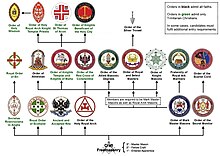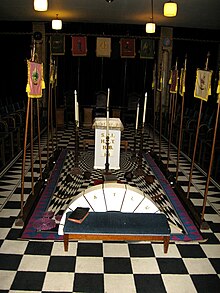The history of Freemasonry encompasses the origins, evolution and defining events of the fraternal organisation known as Freemasonry. It covers three phases. Firstly, the emergence of organised lodges of operative masons during the Middle Ages, then the admission of lay members as "accepted" or "speculative" masons, and finally the evolution of purely speculative lodges, and the emergence of Grand Lodges to govern them. The watershed in this process is generally taken to be the formation of the first Grand Lodge in London in 1717. The two difficulties facing historians are the paucity of written material, even down to the 19th century, and the misinformation generated by masons and non-masons alike from the earliest years.

The Order of Mark Master Masons is an appendant order of Freemasonry that exists in some Masonic jurisdictions, and confers the degrees of Mark Mason and Mark Master.

The Royal Order of Scotland is an appendant order within the structures of Freemasonry. Membership is an honour extended to Freemasons by invitation. The Grand Lodge of the Royal Order of Scotland is headquartered in Edinburgh, with a total of 88 subordinate Provincial Grand Lodges; of these, the greatest concentration is in the British Isles, with the rest located in countries around the world.

The Knights Templar, full name The United Religious, Military and Masonic Orders of the Temple and of St John of Jerusalem, Palestine, Rhodes and Malta, is a fraternal order affiliated with Freemasonry. Unlike the initial degrees conferred in a regular Masonic Lodge, which only require a belief in a Supreme Being regardless of religious affiliation, the Knights Templar is one of several additional Masonic Orders in which membership is open only to Freemasons who profess a belief in Christianity. One of the obligations entrants to the order are required to declare is to protect and defend the Christian faith. The word "United" in its full title indicates that more than one historical tradition and more than one actual order are jointly controlled within this system. The individual orders 'united' within this system are principally the Knights of the Temple, the Knights of Malta, the Knights of St Paul, and only within the York Rite, the Knights of the Red Cross.
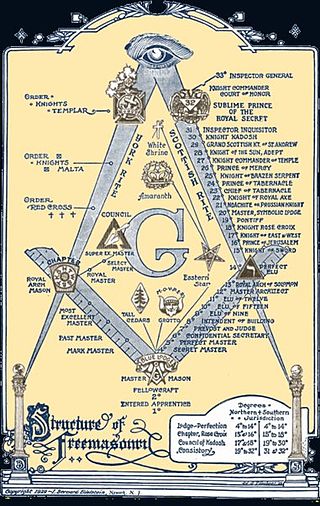
There are many organisations and orders which form part of the widespread fraternity of Freemasonry, each having its own structure and terminology. Collectively these may be referred to as Masonic bodies, Masonic orders, Concordant bodies or appendant bodies of Freemasonry.

There are Masonic degrees named after the Knights Templar but not all Knights Templar Orders are Masonic.
Freemasonry in Denmark was first established in 1743 and is today represented by a number of Grand Lodges. The oldest and biggest Masonic Grand Lodge in Denmark is the Danish Order of Freemasons, in English also known as the Grand Lodge of Denmark.
Robert Macoy was born in Armagh, Ulster County, Ireland. He moved to the United States at the age of 4 months. He was a prominent Freemason, and was instrumental in the founding of the Order of the Eastern Star and the Order of the Amaranth. He also founded what may be the largest Masonic publishing, regalia, and supply house currently active, Macoy Publishing & Masonic Supply Company.
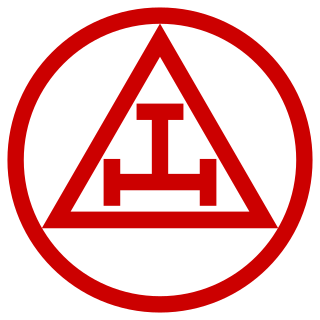
The Royal Arch is a degree of Freemasonry. The Royal Arch is present in all main masonic systems, though in some it is worked as part of Craft ('mainstream') Freemasonry, and in others in an appendant ('additional') order. Royal Arch Masons meet as a Chapter; in the Supreme Order of the Royal Arch as practised in the British Isles, much of Europe and the Commonwealth, Chapters confer the single degree of Royal Arch Mason.
The Allied Masonic Degrees (AMD) are a series of Masonic degrees conferred by Councils of the Allied Masonic Degrees. The Allied Masonic Degrees form an appendant order of Freemasonry that exists in some Masonic jurisdictions; its degrees are conferred only by invitation. Councils of the Allied Masonic Degrees exist in Great Britain, the United States, Canada, France, Australia, India, Benin and Congo, and their members also educate one another by presenting research papers on Freemasonry.

Royal Arch Masonry is the first part of the American York Rite system of Masonic degrees. Royal Arch Masons meet as a Chapter, and the Royal Arch Chapter confers four degrees: Mark Master Mason, Past Master, Most Excellent Master, and Royal Arch Mason.
The history of Freemasonry in Mexico can be traced to at least 1806 when the first Masonic lodge was formally established in the nation.

Thomas Dunckerley was a prominent freemason, being appointed Provincial Grand Master of several provinces, promoting Royal Arch masonry, introducing Mark Masonry to England, and instituting a national body for Templar masonry. This was made possible by an annuity of £100, rising to £800, which he obtained from King George III by claiming to be his father's illegitimate half brother.

Cryptic Masonry is the second part of the York Rite system of Masonic degrees, and the last found within the Rite that deals specifically with the Hiramic Legend. These degrees are the gateway to Temple restoration rituals or the Second Temple Legend. The body itself is known as either the Council of Royal & Select Masters or Council of Cryptic Masons depending on the jurisdiction.
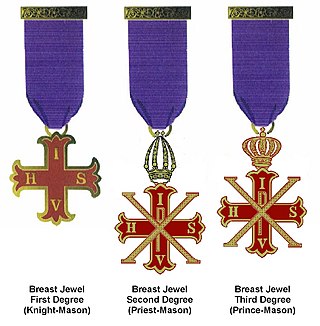
The Red Cross of Constantine, or more formally the Masonic and Military Order of the Red Cross of Constantine and the Appendant Orders of the Holy Sepulchre and of St John the Evangelist, is a Christian fraternal order of Freemasonry. Candidates for the order must already be members of Craft Freemasonry (lodge) and Royal Arch Freemasonry (chapter); they must also be members of the Christian religion, and proclaim their belief in the Christian doctrine of the Holy Trinity.

The Order of Knight Masons is a chivalric Masonic order, open to all Master Masons who are also members of a Mark Lodge and a Royal Arch Chapter. Members of the order meet in Councils of Knight Masons which are governed by the Grand Council of Knight Masons based in Dublin, Ireland. A member of the group is a Knight Mason.
Freemasonry in Scotland in lodges chartered by the Grand Lodge of Scotland comprises the Scottish Masonic Constitution as regular Masonic jurisdiction for the majority of freemasons in Scotland. There are also lodges operating under the Scottish Masonic Constitution in countries outside of Scotland. Many of these are countries linked to Scotland and the United Kingdom through the Commonwealth of Nations and prior colonies and other settlements of the British Empire although there are several lodges in countries such as Lebanon, Belgium, Chile and Peru, which do not have such connections.
The Rite of Baldwyn or Rite of Seven Degrees is one of several Rites of Freemasonry. It exists and is only practised in the Masonic Province of Bristol, England in Freemason's Hall. A Rite is a series of progressive degrees that are conferred by various Masonic organizations or bodies, each of which operates under the control of its own central authority. The Rite of Baldwyn specifically is a collection of separate Masonic Bodies and associated Degrees that would otherwise operate independently. The three primary bodies in the York Rite are the degrees of Craft Freemasonry, the Supreme Order of the Holy Royal Arch, and the Camp of Baldwyn.

In Freemasonry, the first three Masonic degrees constitute the fundamental degrees in all Rites they are called Blue Lodge of Craft degree.






